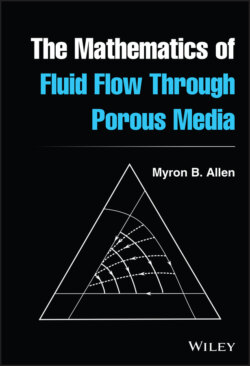Читать книгу The Mathematics of Fluid Flow Through Porous Media - Myron B. Allen III - Страница 12
1.2 Partial Differential Equations (PDEs)
ОглавлениеMost realistic models of fluid flows in porous media use PDEs, “the natural dialect of continuum science” [62], written at scales appropriate for bench‐ or field‐scale observations. In practical applications, these equations are complicated. They are posed on geometrically irregular, multidimensional domains; they often have highly variable coefficients; they can involve coupled systems of equations; in many applications they are nonlinear. For these reasons, we must often replace the exact PDEs by arithmetic approximations that one can solve using electronic machines.
The practical need for computational methods notwithstanding, a grasp of the analytic aspects of the PDEs remains an important asset for any porous‐medium modeler. What types of initial and boundary conditions yield well‐posed problems? Do the solutions obey a priori bounds based on the initial or boundary data? Do the numerical approximations respect these bounds? Does the PDE tend to smooth or preserve numerically problematic sharp fronts as time advances? Do shocks form from continuous initial data?
In the first half of the twentieth century, pioneering numerical analysts Richard Courant, Kurt Friedrichs, Hans Lewy, and John von Neumann—all immigrants to the United States—recognized that one cannot successfully “arithmetize analysis” [23] without understanding the differential equations. Designing stable, convergent, accurate, and efficient approximations to PDEs requires mathematical insight into the equations being approximated. A visionary 1947 consulting report [152] by von Neumann, developing the first petroleum reservoir simulator designed for a computer, illustrates this principle.
This book aims to promote this type of insight. We examine PDE‐based models of porous‐medium flows in geometries and settings simple enough to admit analysis without numerical approximations but realistic enough to reveal important structures.
From a mathematical perspective, the study of fluid flows in porous media offers fertile ground for inquiry into PDEs more generally. In particular, this book employs many broadly applicable concepts in the theory of PDEs, including:
1 Mass and momentum balance laws
2 Variational principles
3 Fundamental solutions
4 The principle of superposition
5 Similarity methods
6 Stability analysis
7 The method of characteristics and jump conditions.
Where possible, the narrative introduces these topics in the simplest possible settings before applying them to more complicated problems.
Topic 1, covered in Chapter 2, deserves comment. Few PDE texts at this level discuss balance laws in the detail pursued here. However, it is hard to build intuition about porous‐medium flows without knowing the principles from which they arise. The balance laws furnish those principles. On the other hand, a completely rigorous study of balance laws for fluids flowing in porous media would require a monograph‐length treatment in its own right. Chapter 2 reflects an attempt to weigh the importance of fundamental principles against the need for a concise explanation of how the governing PDEs emerge from basic laws of physics. The references offer suggestions for deeper inquiry.
We frequently refer to PDEs according to a classification system inherited from the algebra of quadratic equations. The utility of this system becomes more apparent as one becomes more familiar with examples. For now, it suffices to review the system for second‐order PDEs in two independent variables having the form
(1.1)
Here, , , and are functions of the independent variables and , which we can replace with and in time‐dependent problems; is the unknown solution; and denotes a function of five variables that describes the lower‐order terms in the PDE.
The highest-order terms determine the classification. Thediscriminant of Eq. (1.1) is , which is a function of . Equation (1.1) is
hyperbolic at any point of the ‐plane where ;
parabolic at any point of the ‐plane where ;
elliptic at any point of the ‐plane where .
Extending this terminology, we say that a first‐order PDE of the form
is hyperbolic at any point where .
Exercise 1.1 Verify the following classifications, where and are real‐valued with :
Mathematicians associate the wave equation with time‐dependent processes that exhibit wave‐like behavior, the heat equation with time‐dependent processes that exhibit diffusive behavior, and the Laplace equation with steady‐state processes. These associations arise from applications, some of which this book explores, reinforced by theoretical analyses of the three exemplars in Exercise 1.1. For more information about the classification of PDEs, see [65, Section 2‐6].
